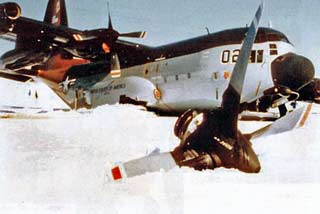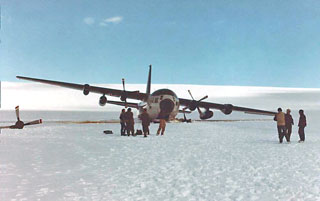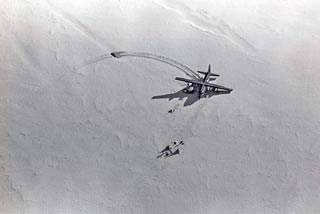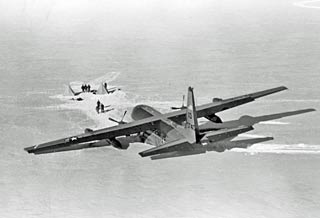The Starshot Glacier incident
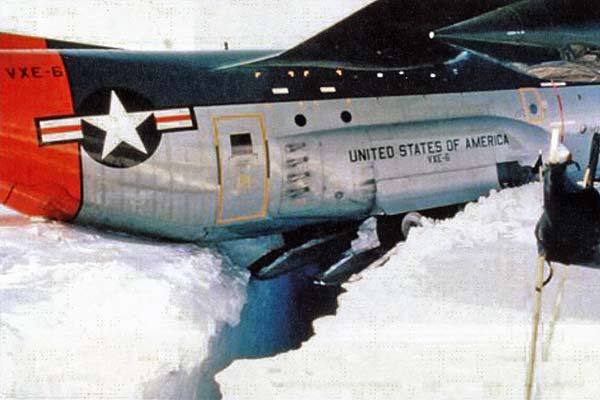
XD-02 after encountering a crevasse while picking up a science team at Starshot Glacier on 28 December 1984 (US Navy photo by William Howe). The story here...a four-person geology science group including geologists Margaret Rees, then at the University of Kansas, and Brian R. Pratt, then at the University of Toronto, along with New Zealand mountaineers Peter Braddock (from Picton) and Ray Waters (from Blenheim). The team was studying Shackleton Limestone and Douglas Conglomerate formations in the Holyoake Range in the Transantarctic Mountains, specifically near the head of the Starshot Glacier. The team was being relocated to another campsite on 28 December 1984 by VXE-6's XD-02. After loading all of their gear (including 4,000 pounds of rocks which were loaded on the ramp), the pilot made an unsuccessful takeoff attempt at around 1400 local time. While turning around to try again, there was a sudden "sinking feeling" as both of the main rear skis went into a crevasse, as seen in the above photo. Two of the propellers (#1, port outboard, and #4, starboard outboard) came loose during the incident, and the aircraft ended up with the rear portion of the fuselage resting on the snow surface and the left wingtip only two feet above the ice. There were large stains of yellow engine oil seeping into the snow. | |
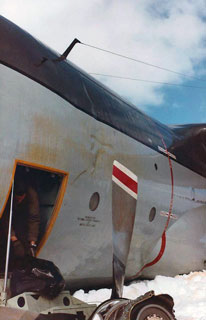 The #1 propeller bounced off the fuselage leaving a dent. Fortunately it had been feathered, otherwise it would have cut into the fuselage and done severe damage to two crew members who were standing inside behind the dent (NL). |
|
|
First and most importantly, no one was hurt. What happened next? The loadmaster (who was wearing a headset connected to the flight deck) told everyone to leave the aircraft quickly, and they all exited through the forward entrance door, stepping over the #1 propeller and gearbox. There was some concern that the aircraft might slip further into the crevasse, so everyone was quickly evacuated without cold weather gear, a radio, or other survival gear. A bit later, some of the ECW, survival gear, and a field radio were recovered from the aircraft. At first, attempts were made to contact McMurdo without success. A later attempt was made, and the weak MAYDAY call was immediately answered by CDR Paul Derocher (then XO of VXE-6) who happened to be passing nearby en route to Pole aboard XD-03...the weak signal was picked up by navigator and radio communicator LCDR Geoffrey Bauer. XD-03 immediately turned around and within a few minutes was flying low over the crash site. CDR Deroucher observed the damage, noted that the aircraft had taxied across more than one crevasse, and warned the folks on the ice not to move around. XD-03 relayed information to McMurdo, but it only had enough fuel to loiter above the site for about an hour. Another squadron Herc was called in and circled the area for nearly nine hours. | |
| . | |
|
The site was 300 miles from McMurdo, within helicopter range. The first of two VXE-6 Huey helicopters arrived at 1800 the day of the crash, and the evacuations began. By 0300 29 December the four-person research team and the aircraft crew (seven men and one woman) had been evacuated to McMurdo. An LC-130 then brought in pumps and fuel for a helicopter refueling station, and another LC-130 that evening brought in a joint NZ-US search-and-rescue team who marked off the crevassed areas. | |
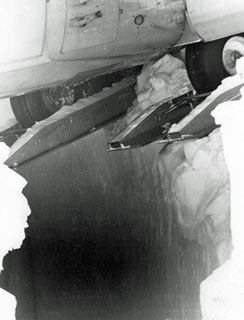 A close look at the crevasse, one report was that it was at least 150 feet deep and could have swallowed the aircraft if it had approached from another angle (WH, who took this photo with a rope around his waist). |
|
|
So, what happened next? Pumps, air lifting bags, and two tracked vehicles were flown to McM from NZ and then sent to what had become the "Starshot Glacier repair camp" for use in lifting the aircraft out of the crevasse. As an air bag under the ramp was inflated, its pressure on the sloped ramp started to move the aircraft forward, as a D8 (not LGP) pulled it out of the crevasse area by 6 January. It then taxied on its available 2 engines to a repair camp site which had been set up 1-1/2 miles away. It isn't clear who all was involved with the recovery effort, but it apparently involved civil engineers on the Deep Freeze staff, Seabees, and ITT/ANS contract employees. Two engines and propellers were replaced at the field camp, and the aircraft was flown out to McMurdo on 11 January, and then on to Christchurch on 14 January where further repairs were made. | |
|
Credits and thanks: First, the photos and photo comments: NL is Nelson Locke who was on the flight crew, and WH is photographer's mate William Howe who flew to the site on the LC-130 that put in the helicopter fuel cache and then did initial assessment photography. Additional information was provided by crew member David LeClare. LCDR Geoffrey Bauer who first picked up the weak radio signal from XD-02, provided additional information and a correction. Other documentation: two October 1985 Antarctic Journal articles including this report of VXE-6 1984-85 activity and this account of the geology team's activities; an article "Hercules retrieved from Starshot Glacier crevasse" in Antarctic (journal of the NZ Antarctic Society) volume 10 number 8, December 1984; and "The Ice: A personal account of flying in Antarctica" by Captain Paul Derocher, US Navy" in Flights of Adventure, a 2009 book by Ken Larson. | |
